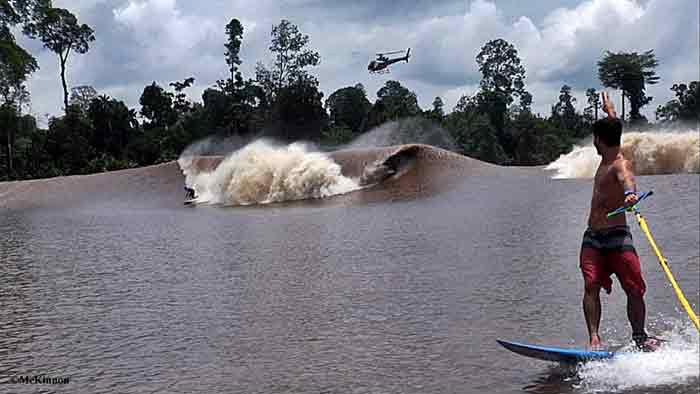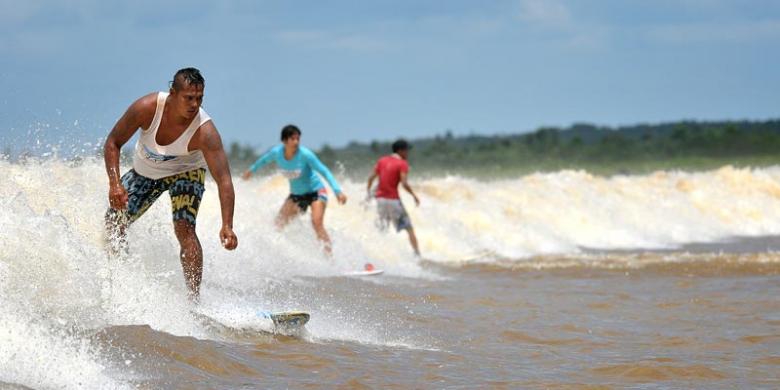Braving crocodiles, mechanical malfunction and remote distances from medical help are some of the sacrifices one makes in order to surf the Seven Ghosts on Kampar river deep in the Sumatran interior far from the ocean. Named the Seven Ghosts during a groundbreaking exploratory surf mission there last year, the wave is an apparition that only appears around extreme lunar tide pushes and then vanishes like a ghost until the moon summons it again. The locals call this river wave the Bono and are respectful and cautious of its ship sinking and village flooding intensity that can travel up to 130 km upriver. Surfers call this river wave amazing with rides lasting over 20 minutes each, or until your legs collapse, something that never happens on ocean waves.

The wave can rise up to 10 feet and travel up to 50 kilometers — in theory you can ride this beast more than one hour.
Scientifically explained the Bono is an Indonesian tidal bore, or an extremely fast moving river wave pushed upriver by extreme full moon tidal fluctuations. Similar tidal bores have already been surfed on rivers in the Amazon, in China, and England, but the rumours were that deep in Indonesia existed a certain tidal bore named the Bono that formed a perfect surfing wave second to none. Last year’s Seven Ghosts trip was not the first journey there, but was definitely the most amazingly photographed surfing conditions on a river wave ever.
Harnessing the power of such river waves cannot be done by human strength alone. The incoming tidal bore meets down flowing river head on at fast speeds, creating a wave that has a difficult wash and lightning fast-moving current to it. The speed and varying shape of tidal bore waves are so unique and fast changing that the only way to catch a ride on the Bono is by being pulled onto it at full speed by jet ski or fast boat. If you fall you could be lost in the jungle, or even worse, found by a crocodile, more situations where a jet ski is vital. More importantly you need jet ski speed to catch back up to the Bono for another wave after falling. Having these types of watercraft are not only necessary for surfing the Bono; in the end they are also tools for survival.
The logistics of providing jet skis or fast boats on this sort of surf trip are not very easy to cover. Most difficult to plan is the location that is so tucked away into the Sumatran jungle and far from beaches and lakes where such watercraft are commonly found. With enough planning and know-how though it is possible to do and for those willing enough to search and discover this natural phenomenon, surfing the Bono becomes an opportunity of a lifetime.

The first real video of the Bono in full bloom last year was watched online at Seven Ghosts on YouTube. At first it looked like a mirage, too bizarre to be true. Helicopter shots showed lines of rolling waves marching their way upriver that would break, reform, break again and then barrel in order and disorder along many parts of an Indonesian riverbank. Primary forest backgrounded the Bono discovery, with Photoshop-quality green trees towering over chocolate water as the Bono wave pushed through the river. Some parts of the Bono resembled unbroken waves peeling towards nowhere, some parts looked like rolling mini-tsunamis of white water, while other sections of the river formed waves more perfect than any ocean wave ever seen.

No other surf trip had ever encountered such an unusual wave in such an unlikely location before the Seven Ghosts trip. Earlier this year another exploratory surf trip had been completed by an Indonesian and international team that also found prime surfing conditions at the Bono. This time around an independent mini-documentary was filmed that will be released later this year called “Water from the Moon.” This mini-documentary brings to life the sinking boats, crocodiles, travails and triumphs of surfing this wave powered by the moon. In the bigger picture the Bono is yet another shining example of how Indonesia has the most perfect waves in the world, even on rivers.
The longest surfing ride on a river bore was 17.2 km (10.6 mi), achieved by James Cotton (Australia), surfing the Bono tidal bore on the Kampar River, Sumatra, Indonesia, on 10 March 2016.
The height of the face of the wave was up to 8 foot at its highest, and was travelling at approximately 20kmph. The record attempt was to raise funds for the Human Variome Project, a project dedicated to sharing genetic data to save lives and reduce disease.
You have to see it to believe it.
Source and reference:
Kompas.com



















